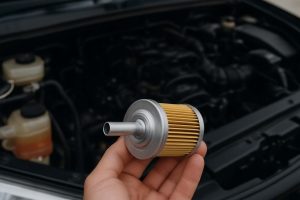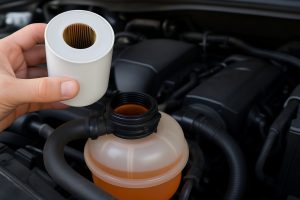Your car’s cooling system plays a critical role in maintaining optimal engine temperature, preventing overheating, and ensuring smooth performance. While many vehicle owners focus on coolant levels and radiator health, an often overlooked yet essential component is the car coolant filter. This small but vital part helps protect your engine by filtering out hidden contaminants that could otherwise cause corrosion, blockages, and damage to your cooling system.
In this article, we’ll explain what coolant filters are, how they work, why they matter, and how proper maintenance can save you costly repairs. We’ll also provide helpful tables and tips to guide you through selecting and caring for your coolant filter.
What Is a Car Coolant Filter?

A car coolant filter is a filtration device integrated within the cooling system designed to trap impurities and debris present in the engine coolant. These contaminants might include rust particles, scale, dirt, and microscopic sediment. The filter prevents these particles from circulating through the radiator, water pump, heater core, and engine block passages.
Why Are Coolant Filters Important?
Protecting Vital Components
Contaminants in coolant can lead to:
-
Clogged passages: Small debris can block narrow coolant channels, restricting flow and reducing cooling efficiency.
-
Corrosion and rust: Metal parts like the radiator and engine block can corrode if impurities are not filtered.
-
Pump damage: The water pump’s impeller can wear down or seize if particles cause abrasion.
-
Heater core blockage: Cabin heating performance may drop if coolant flow is impeded.
Extending System Longevity
A coolant filter reduces the buildup of harmful sediments and deposits, helping extend the lifespan of the entire cooling system.
Maintaining Engine Performance
Consistent and clean coolant flow ensures that your engine maintains the correct operating temperature, preventing overheating and optimizing fuel efficiency.
How Does a Coolant Filter Work?
Typically installed in the coolant return line or integrated inside the radiator or expansion tank, the coolant filter captures particles as the fluid circulates.
Common Types of Coolant Filters:
| Filter Type | Description | Typical Location | Pros | Cons |
|---|---|---|---|---|
| Inline coolant filter | Separate replaceable filter unit in coolant hose | Coolant return line | Easy to replace, effective | Requires installation space |
| Cartridge filter | Built into radiator or coolant reservoir | Inside radiator or tank | Compact, OEM fit | Less accessible for cleaning |
| Magnetic filter | Uses magnets to attract metallic debris | In-line or near pump | Removes metal particles | Doesn’t remove non-metal debris |
Signs Your Coolant Filter Needs Attention
-
Engine temperature fluctuations or overheating
-
Reduced heater performance inside the cabin
-
Coolant discoloration or debris in the reservoir
-
Presence of rust or sludge in the cooling system
-
Coolant leaks or unexplained drops in coolant level
Coolant Filter Maintenance Tips
Proper maintenance is essential to ensure your coolant filter performs well:
| Maintenance Task | Recommended Frequency | Purpose |
|---|---|---|
| Inspect coolant filter | Every coolant change (2-3 years) | Detect clogging or damage |
| Replace coolant filter | Every 40,000-60,000 km or as specified | Maintain optimal filtration |
| Flush cooling system | Every 2-3 years | Remove accumulated contaminants |
| Check coolant quality | Every oil change or service | Ensure coolant purity |
How to Choose the Right Coolant Filter
When selecting a coolant filter, consider the following factors:
-
Vehicle compatibility: Always choose filters designed for your car make and model.
-
Filter media quality: Opt for filters with fine filtration ratings to trap smaller particles.
-
Ease of maintenance: Consider how easy it is to inspect and replace the filter.
-
Brand and certification: Choose OEM or reputable aftermarket brands that meet industry standards.
Coolant Filter vs. Other Cooling System Filters
| Filter Type | Function | Location | Maintenance Frequency |
|---|---|---|---|
| Coolant Filter | Removes debris from coolant | In-line, radiator, or tank | Every 40,000-60,000 km |
| Radiator Cap Filter | Prevents contaminants entering through cap | Radiator neck or expansion tank | Replace with radiator cap as needed |
| Heater Core Filter | Protects heater core passages | Inside heater core assembly | Usually serviced with heater core replacement |
The Consequences of Neglecting Coolant Filter Care
Ignoring the coolant filter can lead to:
-
Engine overheating and possible damage
-
Premature radiator and pump failure
-
Reduced heater efficiency and passenger comfort
-
Increased repair costs due to corrosion and clogging
Summary: Keeping Your Engine Cool and Protected

A coolant filter might seem like a minor component, but its role in protecting your engine from hidden contaminants is significant. Regular inspection, timely replacement, and using quality filters help maintain your car’s cooling system efficiency and prolong engine life.
If you want to keep your cooling system in top shape and prevent costly breakdowns, consider investing in a high-quality coolant filter tailored for your vehicle.
Where to Buy Quality Coolant Filters
For reliable, OEM-quality coolant filters designed to fit your car perfectly, visit Buy Coolant Filter online. Choose from a wide selection of filters and enjoy fast shipping and expert support.
Final Thoughts
Protecting your engine from hidden contaminants inside the cooling system is essential for long-term vehicle health. Car coolant filters act as silent guardians, ensuring clean coolant circulation, preventing damage, and improving overall engine performance. Pay attention to this vital component during your vehicle’s maintenance schedule and choose trusted quality filters.